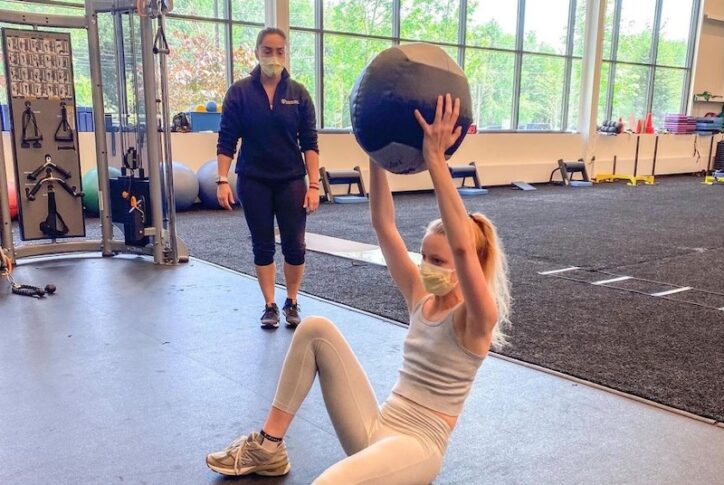Fancy footwork: Two figure skating experts on injury prevention

Amazing costumes, breathtaking artistry, and outstanding athleticism. No wonder figure skating is a Winter Olympics must-watch for millions of people. With the 2022 games fast approaching, Dr. Ellen Geminiani of Boston Children’s Sports Medicine Division has some insights for aspiring athletes watching these spectacles on ice.
“I hope young skaters will think about how much preparation it takes for an athlete to make it to the Olympics. Every single one of those skaters has worked incredibly hard for years.” As a long-time physician for Team USA, she should know. But, she adds, “almost anyone who makes it to that level also loves to skate. That’s key. If you’re going to dedicate your life to something, you’ve got to love what you’re doing.”
Figure skating injuries
Dr. Geminiani and a team of researchers at Boston Children’s and The Micheli Center reviewed 864 figure skating-related injuries. They found some interesting patterns:
- Almost 70 percent of the injuries were overuse injuries caused by repeated stress. The rest were acute injuries caused by a single event, such as a fall or collision.
- In female figure skaters, the most frequently injured areas were the foot and ankle, knee, and back.
- In male figure skaters, the most frequently injured areas were the foot and ankle, hip, and knee.
As the world learned when Simone Biles dropped several gymnastic competitions in last year’s Summer Olympics, many top-level athletes walk a fine line between excellence and injury. Up until recently, injuries were relatively uncommon in figure skating — that’s no longer the case. In fact, Dr. Geminiani and strength and conditioning specialist Ariel Gagnon-Carr have seen a growing number of figure skating injuries, many of which require extended time off from training.
Reducing the rate of injury is possible, but it will take a new approach to training. “Many of the skating injuries we see at The Micheli Center for Sports Injury Prevention could have been prevented with proper strength training,” says Gagnon-Carr. Having skated competitively at the national and international level, she has an insider’s understanding of the sport and what makes skaters tick.
Here we talk with Dr. Geminiani and Gagnon-Carr about figure skating injuries, how to prevent them, and some things to keep in mind while watching the Winter Olympics.
Why are more figure skaters getting injured these days?
Gagnon-Carr: A lot more skaters are trying to do challenging movements that their bodies can’t do. For instance, raising the free leg to parallel during the landing of a jump. If a skater doesn’t have enough hip mobility, they’ll arch their lower back to create the illusion that their leg is higher. Meanwhile, the landing puts eight to 10 times their body weight on their lumbar spine. Landing with an arched back puts extra stress on the lower back.

Dr. Geminiani: On the other end of the injury spectrum are athletes with hypermobile joints. Figure skating involves some pretty extreme positions that athletes with loose joints tend to do very well. A coach may be thrilled when a young athlete can lift their leg over their head. But that position is not a controlled movement, it’s coming from forcing the joint into a position that’s not stable. Over time, this causes the joint to break down, particularly the hip joint. By the time a skater reaches a senior level, they have chronic hip pain. Most skaters and coaches don’t spend enough time on the fundamentals — strength training, mobility, and flexibility. That’s contributing to the rate of injury.
Why do so many skaters have foot and ankle injuries?
Dr. Geminiani: This stems in large part from the design of the skate. Everybody thinks figure skaters have strong ankles. But how are you going to develop ankle strength when your ankle’s locked inside a stiff boot? Unless they’re doing targeted strength training for their ankles, skaters are relying on the boot to support them. Unfortunately, this leads to stress fractures, tendon injuries, tendinopathy, and chronic pain — to name a few of the foot and ankle injuries we see.
What needs to change to reduce the number of figure skating injuries?
Dr. Geminiani: We need to get over the idea that figure skaters have to spend countless hours on the ice at the expense of everything else. Training off the ice helps athletes develop strength and mobility that’s critical to preventing injury. Unfortunately, it’s going to take a culture shift within sports as a whole for many coaches and athletes to embrace this more balanced approach.

Gagnon-Carr: Mental skill training is also key. People forget that figure skating is such a mental sport. I’ve seen incredibly talented skaters who freeze in competition. When an athlete lacks confidence, they’re more likely to get injured. This is why we have specialists who work with athletes on the mental side of performance.
Communication between coaches and athletes is another thing. We see so many injuries that could have been resolved in a week if they’d been addressed sooner. When athletes push through the pain, their injuries can take months to heal. Coaches need to create a safe space for athletes to listen to their bodies, and skaters need to speak up when they’re in pain.
Partners in injury prevention, recovery, and figure skating excellence
The Micheli Center for Sports Injury Prevention, part of Boston Children’s Sports Medicine Division, teamed up with The Skating Club of Boston in 2020. The Skating Club has a long history of excellence in coaching and skating. With expertise in sports medicine, injury prevention, sports nutrition, and mental skills training, The Micheli Center staff and Boston Children’s physicians help figure skaters pursue their skating goals while remaining strong and healthy.
Learn more about Boston Children’s Sports Medicine Division and The Micheli Center for Sports Injury Prevention and book an appointment.
Related Posts :
-

After two ACL tears, a skier reconnects with her body and her sport
The memory remains vivid in Sophia’s mind. Racing down a slalom course at top speed, she hit a patch ...
-

Not just a physical thing: The psychology of sports injuries and recovery
“Nobody plays sports expecting to get injured, but unfortunately, injuries are part of sports,” says Melissa Christino, MD. As a ...
-

Nurturing strength: Tips for parents of female athletes
The drive to succeed can push female athletes to excel at any cost. Female athlete specialist, Dr. Bridget Quinn, talks ...
-

Early sports specialization: How to support your child
Early sports specialization — intensive training and competition in a single sport at the expense of other activities — has become the ...





